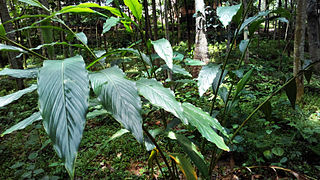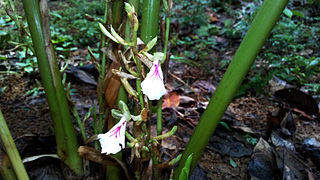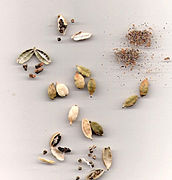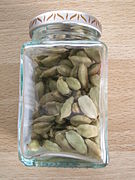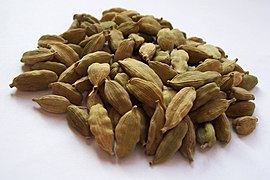Cardamom
| Cardamom | |
|---|---|
Amomum subulatum | |
| Part(s) of plant | Seed |
| Uses | Flavouring, spice, medicine |
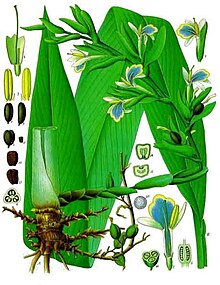
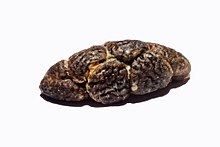
Cardamom (
Species used for cardamom are native throughout tropical and subtropical Asia. The first references to cardamom are found in Sumer, and in the Ayurvedic literature of India.[3] Nowadays it is also cultivated in Guatemala, Malaysia, and Tanzania.[4] The German coffee planter Oscar Majus Klöffer introduced Indian cardamom to cultivation in Guatemala before World War I; by 2000, that country had become the biggest producer and exporter of cardamom in the world, followed by India.[5]
Etymology
The word "cardamom" is derived from the
The earliest attested form of the word κάρδαμον signifying "cress" is the Mycenaean Greek ka-da-mi-ja, written in Linear B syllabic script,[10] in the list of flavourings on the "Spice" tablets found among palace archives in the House of the Sphinxes in Mycenae.[11]
The modern genus name Elettaria is derived from the root ēlam attested in
Types and distribution
The two main types of cardamom are:
- True or green cardamom (or white cardamom[13] when bleached) comes from the species Elettaria cardamomum and is distributed from India to Malaysia. What is often referred to as white cardamon is actually Siam cardamom, Amomum krervanh.[14]
- Black cardamom, also known as brown, greater, large, longer, or Nepal cardamom, comes from the species Amomum subulatum and is native to the eastern Himalayas and mostly cultivated in Eastern Nepal, Sikkim, and parts of Darjeeling district in West Bengal of India, and southern Bhutan.
The two types of cardamom, καρδάμωμον and ἄμωμον, were distinguished in the fourth century BCE by Theophrastus. He reports that some people believed they came from Media, others from India.[15]
Uses
Both forms of cardamom are used as flavourings and cooking spices in both food and drink, and as medicine. E. cardamomum (green cardamom) is used as a spice, a masticatory, or is smoked.[16]
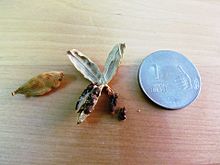
Food and beverage

Cardamom has a strong taste, with an aromatic, resinous fragrance. Black cardamom has a more smoky – though not bitter – aroma, with a coolness some consider similar to mint.[who?]
Green cardamom is one of the most expensive spices by weight,[17] but little is needed to impart flavour. It is best stored in the pod, as exposed or ground seeds quickly lose their flavour. Grinding the pods and seeds together lowers both the quality and the price. For recipes requiring whole cardamom pods, a generally accepted equivalent is 10 pods equals 1+1⁄2 teaspoons (7.4 ml) of ground cardamom.[citation needed]
Cardamom is a common ingredient in Indian cooking. It is also often used in

In Asia, both types of cardamom are widely used in both sweet and savoury dishes, particularly in the south. Both are frequent components in such spice mixes as Indian and Nepali
In Korea, Tavoy cardamom (
Composition
The
In the seeds of round cardamom from Java (Wurfbainia compacta), the content of essential oil is lower (2 to 4%), and the oil contains mainly 1,8-cineol (up to 70%) plus
World production
| Top ten producers of cardamom – 2017 | |
|---|---|
| Country | Production (tonnes) |
| 36,259 | |
| 34,385 | |
| 30,000 | |
| 6,521 | |
| 3,013 | |
| 2,775 | |
| 1,086 | |
| 738 | |
| 555 | |
| 490 | |
| World | 115,822 |
| Source: FAOSTAT of the United Nations[19]
| |

By the early 21st century, Guatemala became the largest producer of cardamom in the world, with an average annual yield between 25,000 and 29,000 tonnes. The plant was introduced there in 1914 by Oscar Majus Kloeffer, a German coffee planter.[5][20] India, formerly the largest producer, since 2000 has been the second worldwide,[20] generating around 15,000 tonnes annually.[21]
Increased demand since the 1980s, principally from China, for both A. villosum and A. tsao-ko, has been met by farmers living at higher altitudes in localized areas of China, Laos, and Vietnam, people typically isolated from many other markets.[22][23][24]
History

Cardamom production began in ancient times, and has been referred to in ancient Sanskrit texts as ela.[25] The Babylonians and Assyrians recognized the health benefits of the spice early on, and trade in cardamom opened up along land routes and by the interlinked Persian Gulf route controlled from Dilmun as early as the third millennium BCE Early Bronze Age,[26] into western Asia and the Mediterranean world.
The ancient Greeks thought highly of cardamom, and the Greek physicians
In China, Amomum was an important part of the economy during the
The Portuguese became involved in the trade in the 16th century, and the industry gained wide-scale European interest in the 19th century.[27]
Production practices
According to Nair (2011), in the years when India achieves a good crop, it is still less productive than Guatemala.[29] Other notable producers include Costa Rica, El Salvador, Honduras, Papua New Guinea, Sri Lanka, Tanzania, Thailand, and Vietnam.[29]
Much production of cardamom in India is cultivated on private property or in areas the government leases out to farmers.
Plants may be raised from seed or by division of the rhizome. In about a year, the seedlings reach about 30 cm (1 ft) in length, and are ready for transplantation. The flowering season is April to May, and after swelling in August and September, by the first half of October usually attain the desired degree of ripening. The crop is accordingly gathered in October and November, and in exceptionally moist weather, the harvest protracts into December.[31] At the time of harvesting, the scapes or shoots bearing the clusters of fruits are broken off close to the stems and placed in baskets lined with fresh leaves. The fruits are spread out on carefully prepared floors, sometimes covered with mats, and are then exposed to the sun. Four or five days of careful drying and bleaching in the sun is usually enough. In rainy weather, drying with artificial heat is necessary, though the fruits suffer greatly in colour; they are consequently sometimes bleached with steam and sulphurous vapour or with ritha nuts.[31]
The industry is highly labour-intensive, each hectare requiring considerable maintenance throughout the year. Production constraints include recurring climate vagaries, the absence of regular re-plantation, and ecological conditions associated with deforestation.[32]
Cultivation


In 1873 and 1874,
In 1979–1980, Guatemala surpassed India in worldwide production.[29] Guatemala cultivates Elettaria cardamomum, which is native to the Malabar Coast of India.[38] Alta Verapaz Department produces 70 percent of Guatemala's cardamom.[38] Cardamom was introduced to Guatemala before World War I by the German coffee planter Oscar Majus Kloeffer.[39] After World War II, production was increased to 13,000 to 14,000 tons annually.[27]
In addition to Guatemala and India, Sri Lanka, Nepal, Papua New Guinea and Tanzania are also significant growers of cardamom.
Trade
Cardamom production's demand and supply patterns of trade are influenced by price movements, nationally and internationally, in 5 to 6-year cycles.[41] Importing leaders mentioned are Saudi Arabia and Kuwait,[42] while other significant importers include Germany, Iran, Japan, Jordan, Pakistan, Qatar, United Arab Emirates, the UK, and the former USSR.[43] According to the United Nations Conference on Trade and Development, 80 percent of cardamom's total consumption occurs in the Middle East.[43]
In the 19th century,
Gallery
-
Black and green cardamom
-
Cardamom plant (one year old)
-
Leaves of cardamom
-
Cardamom flowering stems
-
Cardamom flower
-
Pollen grain of Cardamom
-
Cardamom fruit and seeds
-
Green cardamom pods and seeds
-
Jar of green cardamom
-
White cardamom pods in a bowl
-
Cardamom pods as used as a spice in India
See also
- Aframomum corrorima, known as Ethiopian cardamom
References
![]() This article incorporates text from this source, which is in the public domain: G. Watt's "The Commercial Products of India: Being an Abridgement of "The Dictionary of the Economic Products of India."" (1908)
This article incorporates text from this source, which is in the public domain: G. Watt's "The Commercial Products of India: Being an Abridgement of "The Dictionary of the Economic Products of India."" (1908)
![]() This article incorporates text from this source, which is in the public domain: T. C. Owen's "Notes on Cardamom Cultivation" (1883)
This article incorporates text from this source, which is in the public domain: T. C. Owen's "Notes on Cardamom Cultivation" (1883)
- Cambridge Dictionary. Retrieved 10 April 2024.
- ISBN 978-3-031-35426-7.
- ISBN 978-0851996059. Archivedfrom the original on 30 June 2023. Retrieved 6 October 2020.
- ISBN 978-0851996059. Archivedfrom the original on 30 June 2023. Retrieved 6 October 2020.
- ^ a b Shenoy Karun, Kerala cardamom trying to fight off its Guatemalan cousin", The Times of India, 21 April 2014 Archived 30 April 2014 at the Wayback Machine; accessed 25 July 23014.
- ^ Lewis, Charlton T.; Short, Charles, "cardamomum", A Latin Dictionary, Perseus Digital Library at Tufts University, archived from the original on 28 September 2021, retrieved 20 February 2021
- ^ Liddell, Henry George; Scott, Robert, καρδάμωμον, A Greek-English Lexicon (in Ancient Greek), Perseus Digital Library at Tufts University, archived from the original on 24 October 2021, retrieved 20 February 2021
- ^ Liddell, Henry George; Scott, Robert, "κάρδαμον", A Greek-English Lexicon, Perseus Digital Library at Tufts University, archived from the original on 17 October 2021, retrieved 20 February 2021
- ^ Liddell, Henry George; Scott, Robert, "ἄμωμον", A Greek-English Lexicon (in Ancient Greek), Perseus Digital Library at Tufts University, archived from the original on 6 April 2022, retrieved 20 February 2021
- ^ "ka-da-mi-ja" Archived 15 May 2011 at the Wayback Machine at Palaeolexicon
- ^ Chadwick, John, ed. (1963), "The Mycenae Tablets, 3", Transactions of the American Philosophical Society, vol. 52, no. 7 (New Series ed.)
- ^ Burrow, Thomas; Emeneau, M. B. A Dravidian Etymological Dictionary. Archived from the original on 22 June 2020. Retrieved 2 August 2014.
- ^ Bhide, Monica. "Queen of Spices" Archived 24 May 2015 at the Wayback Machine, Saveur, 8 March 2010. Retrieved on 4 December 2014.
- ^ Katzer, Gernot. "Spice Pages: Cardamom Seeds (Elettaria cardamomum)". gernot-katzers-spice-pages.com. Archived from the original on 8 December 2012. Retrieved 4 April 2017.
- ^ Theophrastus IX.vii.2
- ^ "The Uses of Cardamom". Garden Guides. 21 September 2017. Archived from the original on 22 October 2016. Retrieved 29 May 2018.
- ^ "Is Cardamom a Spice?". The Spruce Eats. Archived from the original on 30 January 2019. Retrieved 29 January 2019.
- .
- Food and Agriculture Organization of the United Nations, Statistical Division (FAOSTAT). 2022. Archivedfrom the original on 12 November 2016. Retrieved 10 September 2022.
- ^ a b Álvarez, Lorena; Gudiel, Vernick (14 February 2008). "Cardamom prices leads to a re-emergence of the green gold". El Periodico (in Spanish). Archived from the original on 11 May 2011. Retrieved 18 February 2008.
- ^ Batres, Alexis (6 August 2012). "Looking for new markets". El Periodico (in Spanish). Guatemala. Archived from the original on 19 April 2014.
- northwest Vietnam. Agricultural Research and Extension Network, Overseas Development Institute, London.
- ISBN 0295741732
- Bogor, Indonesia.
- ^ a b Cumo 2013, p. 215.
- ISBN 9048127181
- ^ a b c d Cumo 2013, p. 216.
- ^ ISBN 0415927463.
- ^ a b c Nair 2011, p. 267.
- ^ a b c d e Kusters & Belcher 2004, p. 136–46.
- ^ a b c d Watt 1908, p. 514.
- ^ Nair 2011, p. 270.
- ^ a b Owen 1883, p. 1.
- ^ Watt 1908, p. 516.
- ^ Kulkarni, Mahesh (2 September 2013). "Cardamom output to fall for second year in a row". Business Standard. Archived from the original on 29 November 2014. Retrieved 14 November 2014.
- ^ Krishnakumar, P. K. (6 August 2014). "Cardamom production set to fall 40%". The Economic Times. Archived from the original on 18 December 2014. Retrieved 14 November 2014.
- ^ "Prof. K.M. Chandy – Governor of Gujarat". Raj Bhavan, Gujarat Government. Archived from the original on 25 April 2012. Retrieved 15 November 2014.
- ^ USDA Foreign Agricultural Service. Archived from the original(PDF) on 4 March 2016. Retrieved 15 November 2014.
- ^ Karun, Shenoy (21 April 2014). "Kerala cardamom trying to fight off its Guatemalan cousin". The Times of India. Archived from the original on 8 March 2015. Retrieved 14 November 2014.
- ^ "5.4 Edible plant products". FAO. Archived from the original on 27 November 2014. Retrieved 14 November 2014.
- ^ Nair 2011, p. 277.
- ^ a b Parthasarathy, Chempakam & Zachariah 2008, p. 41.
- ^ a b Nair 2011, p. 278.
- ^ Giriappa, S. Plantation Economy in India at Google Books
- ^ Watt 1908, p. 517.
- ^ Nair 2011, p. 267–268.
- ^ Bell 1843, p. 387.
Bibliography
- Bell, Jacob (1843). Pharmaceutical Journal: A Weekly Record of Pharmacy and Allied Sciences. Vol. II, No. 1 (Public domain ed.). London: John Churchill.
- Cumo, Christopher Martin (25 April 2013). Encyclopedia of Cultivated Plants: From Acacia to Zinnia [3 Volumes]. ABC-CLIO. ISBN 978-1-59884-775-8.
- Kusters, Koen; Belcher, Brian (2004). Forest Products, Livelihoods and Conservation. Center for International Forestry Research. ISBN 978-979-3361-23-9.
- Nair, K. P. Prabhakaran (2011). Agronomy and Economy of Black Pepper and Cardamom: The "King" and "Queen" of Spices. Elsevier. ISBN 978-0-12-391865-9.
- Owen, T. C. (1883). Notes on Cardamom Cultivation (Public domain ed.). A. M. & J. Ferguson.
- Parthasarathy, V. A.; Chempakam, Bhageerathy; Zachariah, T. John (2008). Chemistry of Spices. CABI. ISBN 978-1-84593-420-0.
- Watt, Sir George (1908). The Commercial Products of India: Being an Abridgement of "The Dictionary of the Economic Products of India." (Public domain ed.). J. Murray. p. 514.
- CardamomHQ: In-depth information on Cardamom
- ISBN 0-521-34060-8
- Gernot Katzer's Spice Pages: Cardamom
- Plant Cultures: botany and history of Cardamom Archived 27 August 2008 at the Wayback Machine
- Pham Hoang Ho 1993, Cay Co Vietnam [Plants of Vietnam: in Vietnamese], vols. I, II & III, Montreal.
- Buckingham, J.S. & Petheram, R.J. 2004, Cardamom cultivation and forest biodiversity in northwest Vietnam, Agricultural Research and Extension Network, Overseas Development Institute, London UK.
- Aubertine, C. 2004, Cardamom (Amomum spp.) in Lao PDR: the hazardous future of an agroforest system product, in 'Forest products, livelihoods and conservation: case studies of non-timber forest products systems vol. 1-Asia, Center for International Forestry Research. Bogor, Indonesia.


